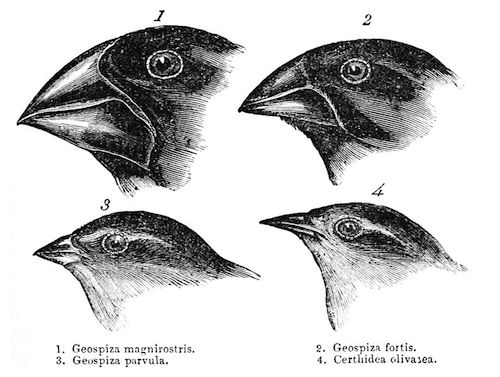 Evolution
Evolution
Nature: Galápagos Finch “Species” Can Interbreed

The Galápagos finches are often touted as a great example of an adaptive radiation, showing how new species can arise through evolutionary processes. A new article in Nature by Galápagos finch researchers Peter and Rosemary Grant, “Speciation undone,” confirms what we we’ve said here in the past — Galápagos finch species are capable of interbreeding — but adds a new twist: they’re interbreeding so much that in multiple cases, two “species” may be fusing back into one species.
According to the article, “New observations suggest that two species of Darwin’s finches are hybridizing on a Galápagos island, and that a third one has disappeared through interbreeding,” as “one population of Darwin’s finches has become extinct through interbreeding with another.”
Those species are tree finches on Floreana Island, which initially had three species — the “large,” “medium,” and “small” tree finches. It was thought a species of large tree finches arrived first, and then diverged into a “medium” species and “small” species. Later, a new type of “large tree finch” invaded the island, leading to the three species. As the Grants now note, new observations reveal “the large tree finch has disappeared from Floreana!”
Plus, the remaining medium and small species seem to be hybridizing, which they call “speciation in reverse.” But you can only have “speciation in reverse” if you had actual speciation in the first place. As I’ve explained before, the biological species concept defines a species as “groups of actually or potentially interbreeding natural populations which are reproductively isolated from other such groups.” So if the “medium” and “small” finches are interbreeding with one another, then they’re not reproductively isolated, meaning they’re not different species, meaning “speciation” never took place in the first place.
Incidentally, this isn’t the only example where Galápagos finch “species” have been observed to interbreed. As the Grants go on to explain:
On the small uninhabited island of Daphne Major, two species of ground finch (genus Geospiza) have been converging morphologically and genetically for more than 30 years as a result of persistent (although rare) introgressive hybridization following a natural change in the food supply. If introgression continues at the same rate, the two species will fuse into one in approximately 40 years.
They end with a telling admission that some famously touted “radiations” of species (like cichlids or the Galápagos finches) might not be so very different, biologically speaking, after all:
Rapid radiations of fishes and finches are especially at risk because their morphological evolution is not accompanied by strong barriers to gene exchange. Uniquely valuable in showing how speciation is done, such species deserve special protection from being artificially undone.
In other words, what we think are separate “species” might not really be that, after all.
